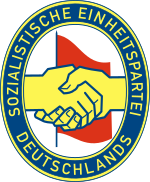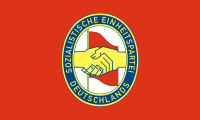Socialist Unity Party of Germany: Difference between revisions
From ProleWiki, the proletarian encyclopedia
m (Expanded infobox.) Tag: Visual edit |
(Using updated parameters (from political_line to political_orientation)) |
||
| Line 1: | Line 1: | ||
{{Infobox political party|name=Socialist Unity Party of Germany|native_name=Sozialistische Einheitspartei Deutschlands|logo=SUPG logo.png|founded=21 April 1946|abbreviation=SED|dissolved=16 December 1989|newspaper=''Neues Deutschland''|youth_wing=Free German Youth|membership_year=1989|membership=2,260,979| | {{Infobox political party|name=Socialist Unity Party of Germany|native_name=Sozialistische Einheitspartei Deutschlands|logo=SUPG logo.png|founded=21 April 1946|abbreviation=SED|dissolved=16 December 1989|newspaper=''Neues Deutschland''|youth_wing=Free German Youth|membership_year=1989|membership=2,260,979|political_orientation=[[Marxism-leninism]]|symbol=[[File:Socialist Unity Party flag.png]]}} | ||
The '''Socialist Unity Party of Germany''' was the most popular party in the [[German Democratic Republic (1949–1990)|German Democratic Republic]]. Despite never holding a majority of seats on the [[Volkskammer]] (the most was 30% in 1949),<ref>{{Citation|author=Dieter Nohlen, Philip Stöver|year=2010|title=Elections in Europe: A data handbook|chapter=|section=|page=771–792|quote=|pdf=|city=|publisher=|isbn=9783832956097|doi=|lg=|mia=|title-url=|chapter-url=|trans-title=|trans-lang=}}</ref> the GDR is referred to as a [[one-party state]] by the [[Bourgeois media|corporate media]]. | The '''Socialist Unity Party of Germany''' was the most popular party in the [[German Democratic Republic (1949–1990)|German Democratic Republic]]. Despite never holding a majority of seats on the [[Volkskammer]] (the most was 30% in 1949),<ref>{{Citation|author=Dieter Nohlen, Philip Stöver|year=2010|title=Elections in Europe: A data handbook|chapter=|section=|page=771–792|quote=|pdf=|city=|publisher=|isbn=9783832956097|doi=|lg=|mia=|title-url=|chapter-url=|trans-title=|trans-lang=}}</ref> the GDR is referred to as a [[one-party state]] by the [[Bourgeois media|corporate media]]. | ||
Revision as of 13:18, 14 November 2022
Socialist Unity Party of Germany Sozialistische Einheitspartei Deutschlands | |
|---|---|
 | |
| Abbreviation | SED |
| Founded | 21 April 1946 |
| Dissolved | 16 December 1989 |
| Newspaper | Neues Deutschland |
| Youth wing | Free German Youth |
| Membership (1989) | 2,260,979 |
| Political orientation | Marxism-leninism |
| Election symbol | |
 | |
The Socialist Unity Party of Germany was the most popular party in the German Democratic Republic. Despite never holding a majority of seats on the Volkskammer (the most was 30% in 1949),[1] the GDR is referred to as a one-party state by the corporate media.
History
In 1946, the Social Democratic Party and Communist Party merged to form the Socialist Unity Party. The Socialist Unity Party was part of the National Front along with several other parties, including some non-leftist parties. In 1989, the party was split into the Social Democratic Party and the Party for Democratic Socialism, which finished second and third respectively behind the right-wing Alliance for Germany.
References
| Part of a series on |
| Communist parties |
|---|
- ↑ Dieter Nohlen, Philip Stöver (2010). Elections in Europe: A data handbook (pp. 771–792). ISBN 9783832956097